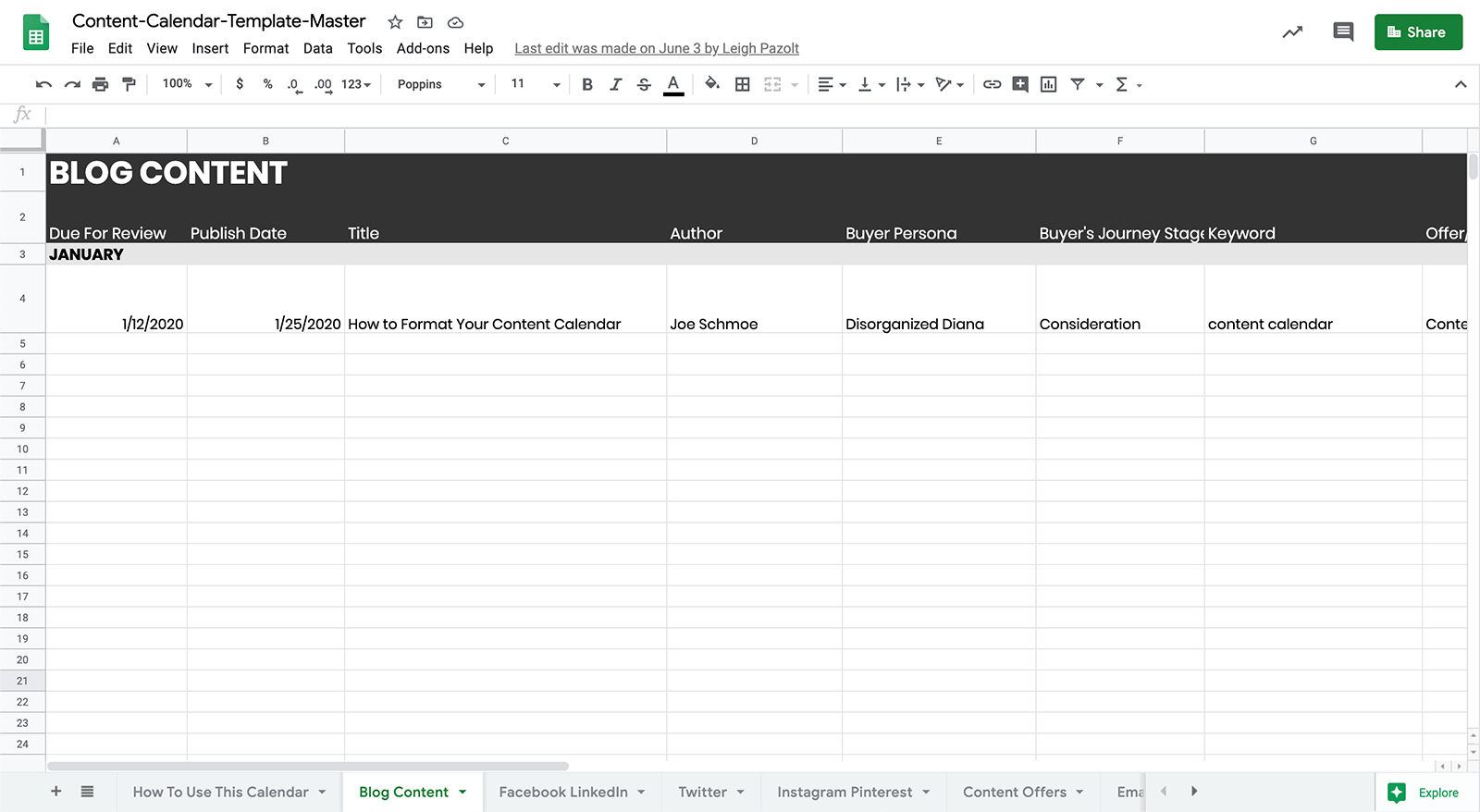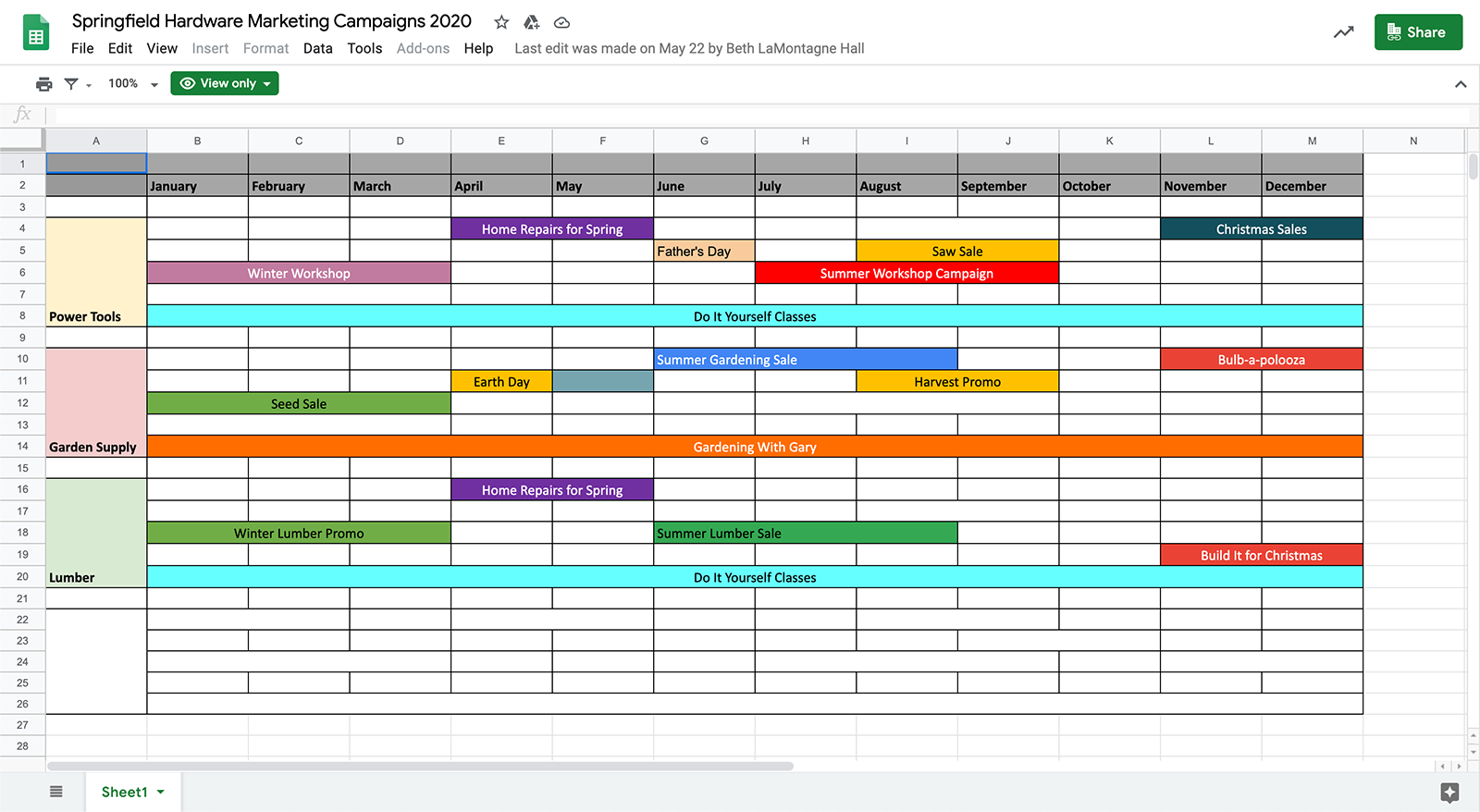At the heart of every inbound marketing strategy is content. It’s essential to attracting new prospects to your business and nurturing them into becoming customers. Inbound marketing master Neil Patel says an effective marketing strategy must focus on “building a strong relationship with your target audience by giving them high-quality content that is very relevant to them on a consistent basis.”
Here’s the problem—you get building relationships, your team is producing amazing content, but you’re struggling with the “consistent basis” part. You need a way to execute your content strategy quickly and efficiently without constantly pushing deadlines. That’s where your content calendar comes in.
Table of Contents
Content plan
Assigning roles
Content process
Who owns the content calendar?
The work that goes in to creating content
How to create a content calendar
Aligning content across channels
Organize by month, quarter, or year?
Sticking to the plan
Perfecting the content process
A content calendar starts with a content plan
There are countless quotes on the importance of planning.
“A goal without a plan is just a wish.”
“By failing to prepare, you are preparing to fail.”
It’s the stuff inspirational posters are made of. We all know planning is important, but the challenge with content is coming up with a way to execute the plan that doesn’t take forever and is something everyone can stick to.
Content planning is the process of generating ideas, assigning tasks, doing those tasks, and keeping track of the work. Your content calendar is the tool that does that last part—keeping it all on track.
Think of your content plan like you would any other process at your company. What are the steps when you launch a new service or product? How do you onboard someone from closed-sale to new customer? Each person involved has a defined role. They know the specific steps to take to accomplish each task, often in a certain order. You might already have a content plan, but if your team is struggling to produce content on a consistent basis, you should revisit it.
As you draft and refine your content plan, it helps to do some data gathering:
- Write down each step your team takes during the process, from drafting content to promoting on social media.
- Document all the channels where you post and promote your content.
- Find where content is being stored, including images and videos.
- Gather all calendars, process outlines, and productivity tools your team is currently using to manage content planning.
Getting all this content-related information together will show you where the gaps and logjams in the process are and help you create a plan that works more efficiently.
Assigning content creation roles
You’ve gathered all your materials, brainstormed some ideas, and are ready to dive into getting some content done. First, you need to assign roles. This should include:
- Who will write the content.
- Who will review the content.
- Who will edit it.
- Who will create images and infographics.
- Who will upload the content and images into the content management system.
- Who has final approval and gives the green light to publish.
- Who will promote it via social media, email, etc.
Ask yourself, who has the skills and the time to perform these roles well and can keep the process moving.
Thinking through your content process
Will blog posts be reviewed in a word processing document or within the CMS? When are social posts cleared to schedule? These questions should be answered as you determine the roles each team member plays. The chronological steps of creating content should be spelled out in a content process document. This can be a simple Word or Google doc everyone can access, but should clearly explain the steps of creating each type of content, from blog posts to webinars.
Who will own the content calendar?
Content calendars are often derailed by a lack of accountability. We get it. Everyone is busy keeping the company running, but if there is no one to step up when an email campaign or content offer has to get out the door, your efforts will stall.
Assign someone to play the role of project manager. Think of this person like the editor-in-chief of your content. It could be the head of marketing, or a senior staffer who’s great at managing team tasks. This person will:
- Oversee the content calendar.
- Work with the team to set publish dates.
- Keep the team accountable to deadlines.
- Be charged with tracking content with goals.
This last aspect, keeping track of goals, is the most easily forgotten. James Brockbank, managing director of Digitaloft, an SEO & digital public relations agency, says that producing content without a clear goal will do very little for your brand.
“You should be able to justify to anyone why you took the decision to write that blog post or design that infographic,” says Brockbank. “Your content should be working toward one or more wider marketing goals.”
Don’t underestimate the work that goes into creating content
“There’s less skill and more plain hard work to writing than anyone except a writer thinks.”
— American mystery writer Mabel Seely
Before you begin any content campaign, consider how much time and effort it takes to produce the content—ALL of it. Managers must allow time for creating it, whether that’s writing, designing, or recording. Time for reviewing, uploading to your CMS, and other administrative steps are often overlooked. Then there’s the time that goes into promoting through social media, email, landing pages, and calls-to-action. Content can easily get derailed by a busy manager who doesn’t have time to review the content her team writes.
If you’re uncertain about how long content creation will take, start with an estimate, then track the time spent, from the outline to publishing. At Raka, we have a free Content Calendar template you can download with a feature that lets you track your time so you can easily see whether you are exceeding your time budget.
Speaking of content calendars…let’s build yours!
How to create a content calendar
As we’ve outlined above, a content calendar gives you a central place for tracking progress and a means of accountability when deadlines slip. Every organization should build its own content calendar based on the type of content they plan to produce and the channels they will use, however, there are a few must-haves for every content calendar.
Content calendar must-haves
- Due date — The date the writer needs to submit the content for review.
- Publish date — The date the content will publish and become available to the public.
- Title — Start with a working title and update when changed.
- Author/owner — the person creating the content.
- Status — is it just an outline or is it awaiting final review? Each team should create their own status levels.
- Keyword — The term you will use to optimize the post.
- CTA/campaign — the purpose of the post, video, or offer. What action are you hoping the reader will take?
- Persona — Name the persona the content is targeting.
- Buyer’s Journey stage — Will the content help the reader during the awareness, consideration, or decision stage?
For social media
- Publish date and time — Pretty self-explanatory.
- Post copy — What the post will say.
- Image/video — Will there be an image or video uploaded with the post?
- URL — Will the post link to anything?
There will also be features specific to your team. When designing the content calendar, include what you need to keep the tasks on track, but not so many items the essentials get lost in the clutter.
Content calendar nice-to-haves
- Time tracking — If you’d like to better budget time for content creation, include a place for team members to log hours spent on tasks.
- Calendar view — A traditional calendar view tab can help you track content around events, launches, and ongoing campaigns.
- Video or webinar tab — If your company regularly produces videos or hosts webinars, you will want to keep track of those assets in a calendar as well, tracking the different steps of the process and who owns them.
If you need help getting a calendar started, check out the template mentioned above. It includes the essentials and some nice-to-haves you can customize for your own team. You can also check out how Hootsuite sets up their social media calendars for a different perspective.
There is no one-size-fits-all content calendar, but make sure the one you design accomplishes two goals: it keeps track of your team’s content tasks and it’s easy to use.
Aligning content across channels
Say you’re a hardware store that wants to increase lawnmower sales by 10%. You sit down with your team and come up with the following content ideas:
- Create an “Ultimate Guide to Purchasing a Lawnmower” gated content offer.
- Publish a series of blog posts with CTAs to the content offer, such as “Honda or Lawn Boy: Which Is Better?”
- Create an ungated comparison chart on your website showing each lawnmowers’ best features.
- Make a short video, “The Five Best Lawn Mowers Right Now.”
- Offer 15% off all lawn mowers.
- Promote all of this in emails and on social media.
That is a lot to keep track of, especially if you have other marketing efforts happening at the same time. Tracking these efforts on one sheet where you can quickly tab across to see how the content is being implemented makes your work a lot easier. It also keeps your team focused on the customer and achieving goals.

Looking at Raka’s content calendar template as an example (above), you can see different tabs for scheduling blog posts, content offers, email campaigns, and different social media channels. While tracking progress on the content offer, your hardware store can shift over to the blog tab to add the content you’ll need to support the offer. Then, head over to the social media tab to draft and schedule posts. This method makes it easy for the team to see what’s been done, what needs to be done, and when it’s all due.
At this point you might be thinking, “Why am I jamming all of these calendars into one giant spreadsheet? Wouldn’t it be easier for one person to own social, one to own the blog content, and another drive content offers?” GREAT question! While every company should take the approach that works best for them, having a bunch of different calendars and different people owning them makes it harder to see how your content is being used across channels.
Should my calendar be organized by month, quarter, or year?
All of the above. For longer-term initiatives, like content offers, it helps to look at what’s planned across the year, while faster-moving content, like social media posts, can be divided by month.
Your company may want to create a master calendar tracking initiatives across the year. Below, we use the hardware store example again, showing how your team could track seasonal marketing efforts, while still being able to dig down into the content that’s going out each day.

Tips for sticking to your content plan
You’ve got your roles defined, you’ve got your calendar, now it’s time to get to work. Here are some common problems that arise and ways you can keep the process moving forward.
Problem 1: Assigning roles without consideration for bandwidth
Some marketing departments have a dozen people. Others have just one person doing it all. If you run a small team, consider how much additional content production it can handle and if you need to hire a freelancer to do some writing or editing.
Problem 2: Assigning someone too many roles
Giving the bulk of your content creation duties to one person is not just about bandwidth. A well-functioning content plan has checks and balances. Having separate writers and editors is a way to maintain a strong, cohesive brand voice, and to keep content tracking with goals. As Ceillie Clark-Keane writes for Wordstream, “Marketers need content editing to make sure they’re generating high-quality content that provides value to readers and contributes to business goals.”
Problem 3: Keeping the process too insular
When we’re in the thick of a project, it’s easy to lose sight of the larger picture. Don’t be afraid to source ideas or run content by people outside of the marketing department. Talk to the sales team about common questions they’re getting about a new product. Ask customer service about any recent complaints or problems. Revisit your buyer personas.
Content must be helpful to your target audience. Using content to continually sell people on a product feature no one likes or hype what a great company you are might make the CEO happy, but it won’t get you more leads.
The content you are creating is for potential customers, not you. It should continually aim to answer the questions and solve the problems of your ideal customer.
Need ideas? Brainstorm together
Some teams are lucky enough to have a fountain of ideas, providing an endless flow of content inspiration. Then there’s the rest of us. To keep the ideas flowing—and aligned with goals—hold periodic brainstorm sessions where you can workshop ideas focused on accomplishing your business goals. Once the meeting is over, don’t forget to send a recap to everyone involved to make sure the ideas are documented.
In between these sessions, create a folder or file where team members put ideas, links, infographics and other assets for future discussion. This could be a link for a third-party social post, or a webinar with a great format your team hopes to replicate. When new initiatives and campaigns arise, scan through the document for ideas that might be helpful.
Perfecting the calendar process
The goal of your content calendar is to reach that Goldilocks Zone where content is flowing smoothly from idea to publish date. Each team member knows his or her role and is using the content calendar to move from one stage to the next. Few companies obtain this state of content nirvana, but having a comprehensive content calendar and a solid content plan will keep you on the path.
A content calendar is a living, breathing document which should change and grow as your content needs do. Whether you rely on our free content calendar download to get started, or create your own content calendar, use it like any other marketing tool—to make everyone’s job easier and your marketing effort more effective.






